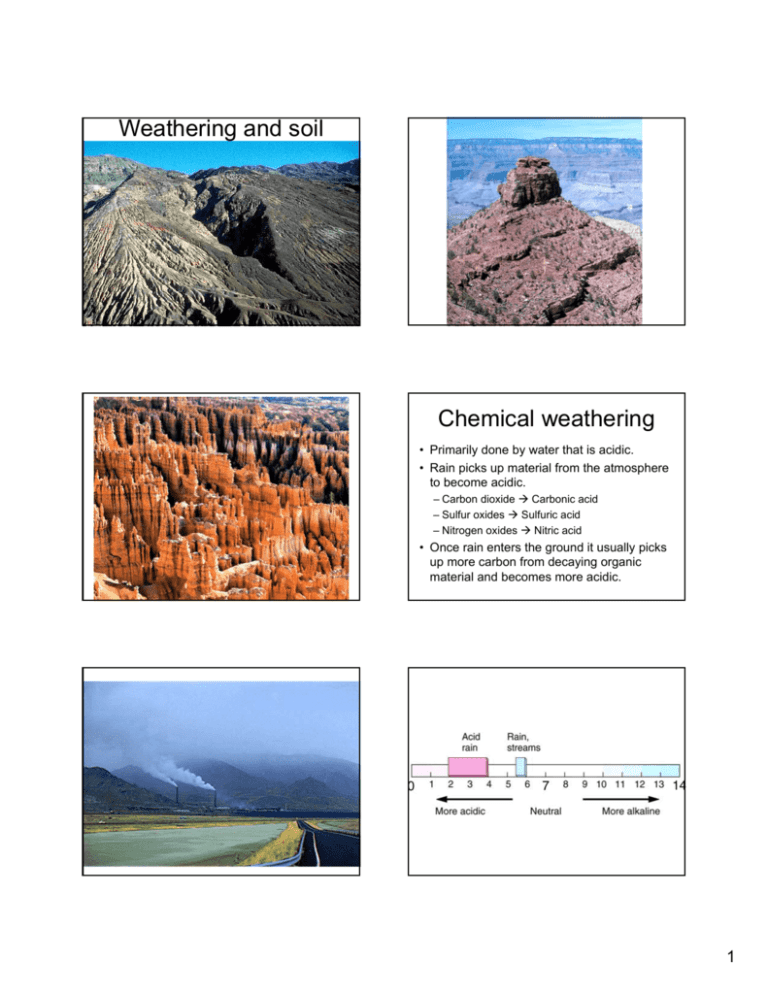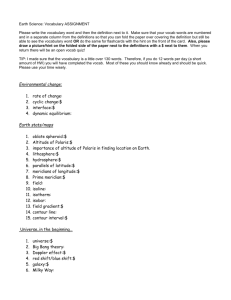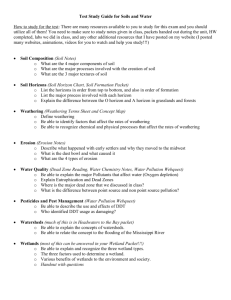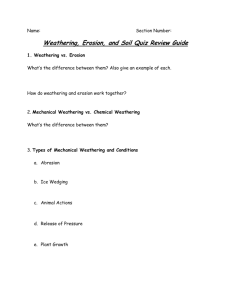Weathering and Soil
advertisement

Weathering and soil Chemical weathering • Primarily done by water that is acidic. • Rain picks up material from the atmosphere to become acidic. – Carbon dioxide Æ Carbonic acid – Sulfur oxides Æ Sulfuric acid – Nitrogen oxides Æ Nitric acid • Once rain enters the ground it usually picks up more carbon from decaying organic material and becomes more acidic. 1 2 Chemical Weathering of Feldspar Potassium feldspar hydrogen ion 4KAlSi3O8 + H+ + water 2H2O Potassium ion kaolinite + Al4Si4O10(OH)8 4K+ silica + 8SiO2 Kaolinite Chemical Weathering of Mafic Minerals • The chemical weathering of mafic (dark colored) minerals like pyroxenes, amphiboles, biotite, etc. (all contain Fe +/- Mg) releases iron which can then form iron oxide (Fe2+O) and goethite (Fe3+)(OH). • These minerals give the weathered rock a red (“rusty”) color. Kspar The reaction of carbonic acid with groundwater and feldspar is a common weathering reaction in most temperate climates (as in Colorado). Typical “Fresh” Igneous Rock 50% quartz 33% Kfeldspar 17% Fe Silicates Products of Weathering pore space or loss to solution Mechanical Weathering • Forces act to break rock apart without chemically altering it. –Impact 75% quartz 17% clay 8% Rust 3 Mechanical Weathering • Forces act to break rock apart without chemically altering it. – Impact –Abrasion Balanced rock from sand abrasion in the desert Mechanical Weathering • Forces act to break rock apart without chemically altering it. – Impact – Abrasion –Frost Wedging 4 Mechanical Weathering • Forces act to break rock apart without chemically altering it. – Impact – Abrasion – Frost Wedging –Root Wedging Mechanical Weathering • Forces act to break rock apart without chemically altering it. – Impact – Abrasion – Frost Wedging – Root Wedging –Salt Wedging Mechanical Weathering • Forces act to break rock apart without chemically altering it. – Impact – Abrasion – Frost Wedging – Root Wedging – Salt Wedging –Unloading 5 Soil vs. Regolith • Regolith = the layer of rock and mineral fragments at the Earth’s surface. • Soil = a combination of mineral and organic matter, water, and air. –The portion of regolith that can support rooted plant growth. Soil Horizons • The most important characteristics used to define soil horizons are: 1. Color 2. Texture 3. Structure 4. Organic Matter Content 5. Moisture Content 6 Soil Horizons - Color • Organics turn soil black to dark brown • Ferric Iron turns the soil yellowbrown to red • Ferrous Iron turns soil dark greygreen • SiO2 or CaCO3 turns the soil light gray to white Carbon rich Reduced (ferrous – Fe+2) iron rich CaCO3 rich 7 Soil Horizons - Texture Soil horizons - structure • Shape of aggregates of soil particles called peds • In clay rich material the spaces between peds may be the only way water can travel down the profile Soil Horizons – Moisture Content Soil Horizons – Organic Matter Content • Litter (leaves and branches) • Humus (decomposed litter) • Both tend to be produced more at higher temperatures, with an optimum of about 25° C • Provides chelates, increase water absorption ability, and makes CO2 to create carbonic acid SOIL PROFILES Five Basic Horizons: O Horizon = Loose and Partially Decayed Organic Matter A Horizon = Loose Rock and Mineral Matter • Total quantity of water that can be held in a soil is the available water capacity (AWC) • Field capacity • Permanent wilting point mixed with Partially Decomposed Organic Matter (Humus) E Horizon = FineFine-grained Mineral Particles that have been carried down by water (Eluviation & Leaching) B Horizon = Accumulation of clay transported from above C Horizon = Loose and Partially Altered “Parent” Parent” Rock Material Parent Rock 8 O horizon • Mostly undecomposed or partially decomposed organic material • Mineral content minor (<50%) A horizon • Mineral horizon with decomposed organic material where clay and mobile components are leached downward • Black, nutrient-rich topsoil • Zone of eluviation E horizon • Intense leaching that removes ferric iron or organic coatings from mineral grains leaving the layer bleached grey or tan Clay tends to get leached from the A and E horizons and carried down to the B horizon due to the electric property of water molecules interacting with the negatively charged surfaces of clay particles. B horizon • Transitional between E and C where material brought down from above accumulates • Zone of illuviation • Commonly has reddish hues, iron and aluminum concentrations, stable primary minerals, and a high clay content 9 C horizon • Underlying, unconsolidated parent materials that have been unmodified/slightly modified, by soil forming processes R horizon Solid bedrock K horizon • A calcite rich layer generally found in arid region • Caliche Soil Forming Factors • • • • • Climate Topography (slope) Parental material Organics Time 10 11 12 13 Soil erosion (of bauxite soils) in Madagascar: clearly unsustainable. 14









